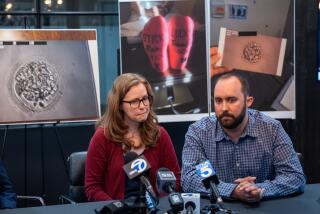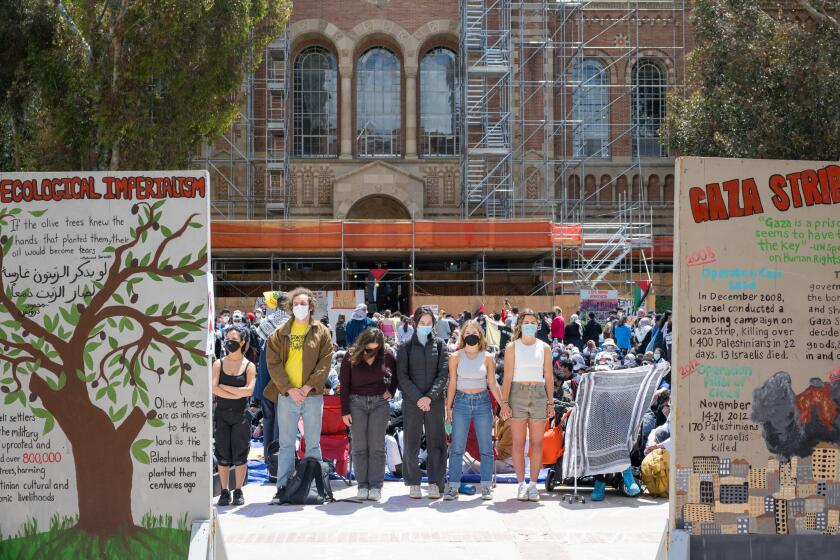Op-Ed: When my daughter tried infertility treatment, she filmed everything
After a frustrating year trying to conceive a child, my daughter Maya and her husband Noah decided to document their journey to parenthood on film.
“Isn’t that a bit risky emotionally?” I asked.
“Why?” she snapped. “We’re gonna have a baby.”
“Adoption?”
“IVF. I want to carry. We’ve looked into it. It’s expensive, and there’s only about a 29% success rate the first time around, but you’ve always told me that nothing’s impossible if you set your mind to it, right?”
“And your mind is pretty set,” I said. “Can I make a contribution?”
“Don’t want your money,” she said. “We’ll find a way.”
And they did. It took most of their savings, some credit card debt, some auctioned artwork and a social media fundraiser, but they managed to cover the cost of in vitro fertilization as well as filming, editing and post-production over a period of three years.
They described their ordeal as a visit to Infertility Island.
It was an eye-opening visit for the whole family. We had no idea how many women struggle to conceive and how many enter that lonely and desperate island. It’s an island where those who cannot make a baby naturally must self-inject drugs, monitor their inner systems daily, submit to ultrasound scans and regulate their hormones. On the island, fear, jealousy and loathing are pervasive. The fear is that nothing will work. The jealousy is projected on to everyone who has or is about to have a child. The loathing is directed against oneself for repeatedly failing in the not-so-simple yet common act of conception.
It is not a pleasant island to visit, and for millions of women, it’s an island they can only leave by abandoning the dream of a family.
Maya and Noah held nothing back. They filmed their most intimate moments, their conversations with their infertility doctor, their interviews with other couples struggling to have their own children. (There are more than 7 million women unable to have a child in the U.S. and probably triple that in countries around the world. According to the Society for Assisted Reproductive Technology, there were 61,740 babies born in the U.S. from IVF procedures and 350,000 worldwide in 2012.)
When a shaman from Mexico passed through L.A., Maya went to see her. She was hung upside down, her feet tied together. The shaman smacked the bottoms of her feet with a stick and mouth-sprayed her body with an herbal concoction.
When Maya’s multiple intrauterine inseminations and her first round of IVF failed, the doctor said her odds of success were low. Apparently Maya’s ovarian reserve was too low. He recommended using an egg donor.
We had no idea how many women struggle to conceive and how many enter that lonely and desperate island.
When Maya asked her sister if she would donate her eggs, it was a trying time for our family, as we weighed the pros and cons of such a contribution. My wife feared that putting our other daughter through the trauma of hormone treatments might affect her chances of conceiving naturally in the future. And I wondered if such a child might cause friction between our daughters when the question arose as to who was the mother and who was the aunt. But Maya’s reasoning was simple: If she was going to use someone else’s eggs, why not her own sister’s?
All of these choices and decisions brought our family closer as it simultaneously made our lives more difficult. We didn’t know that our daughter’s personality would change, how she would separate herself from all her friends who were off having babies, how strained her marriage would be at times. Perhaps what kept Maya and Noah together, and what kept them from giving up, was the very documentary they were committed to making. A documentary they might never have finished if they didn’t have an ending.
Then one day a doctor told Maya about a clinic in Seattle that had frozen embryos available. When she discovered a half-Japanese/half Caucasian embryo, she felt fate had finally turned her way, as that combination matched her own.
It had. The embryo transfer worked. Of course, it wasn’t easy from there. The birth was agonizing and Maya refused any medication. The placenta came out in pieces, causing more trauma after the birth. But the miracle happened. Her child, our grandchild, was born.
They had an ending for their documentary. And a new beginning for the rest of their lives.
Lawrence Grobel is a freelance writer and author of 27 books. Maya and Noah’s documentary, “One More Shot,” will be available on iTunes and Amazon on Nov. 4 and on Netflix beginning Jan. 15.
Follow the Opinion section on Twitter @latimesopinion or Facebook
More to Read
A cure for the common opinion
Get thought-provoking perspectives with our weekly newsletter.
You may occasionally receive promotional content from the Los Angeles Times.






